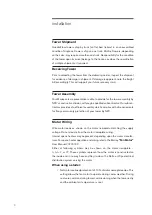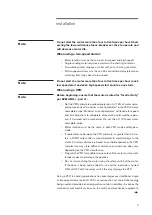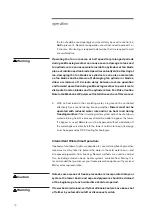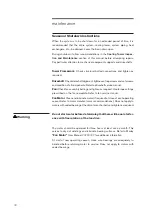
8
3. Water Flow Rate Increasing the water flow rate (m
3
/h) will cause a
slight elevation in cold water temperature, while reducing the water flow
rate will cause the cold water temperature to lower slightly. However, at
a given heat load (see formula above), m
3
/h reductions also cause an
increase in the incoming hot water temperature. Use care to prevent the
hot water from exceeding 52°C, in order to prevent damage to the tower
components.
4. Airflow Rate Reducing airflow through the tower causes the cold water
temperature to rise. This is the approved method by which to control
leaving water temperature.
If your tower is equipped with a single-speed motor, the motor may be
shut off when the water temperature becomes too cold. This will cause
the water temperature to rise. When the water temperature then becomes
too warm for your process, the motor can be restarted.
Fan cycling limits:
Considering the normal fan and motor sizes utilized on Quadraflow
towers, anticipate that approximately 4 to 5 starts per hour are al-
lowable.
If your tower is equipped with a two-speed motor, greater opportunity
for temperature control is afforded you. When the water temperature
becomes too cold, switching the fan to half-speed will cause the cold
water temperature to rise—stabilizing at a temperature a few degrees
higher than before. With a further reduction in water temperature, the
fan may be cycled alternately from half-speed to off.
Do not start the motor more than four to five times per hour (each
low speed start and each high speed start count as one start).
If your tower consists of two or more cells, cycling of motors may be shared
between cells, increasing your steps of operation accordingly. For greater
insight on cold water temperature control, please read
Marley Technical
Report #H-001-A
, “Cooling Tower Energy and its Management”
available for download at spxcooling.com.
Note
Note
installation








































